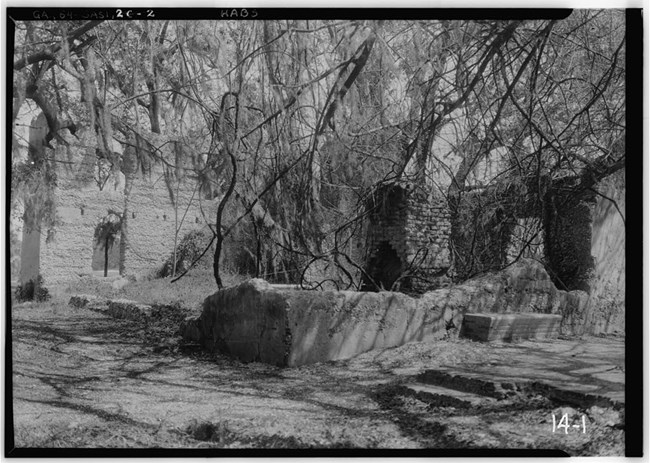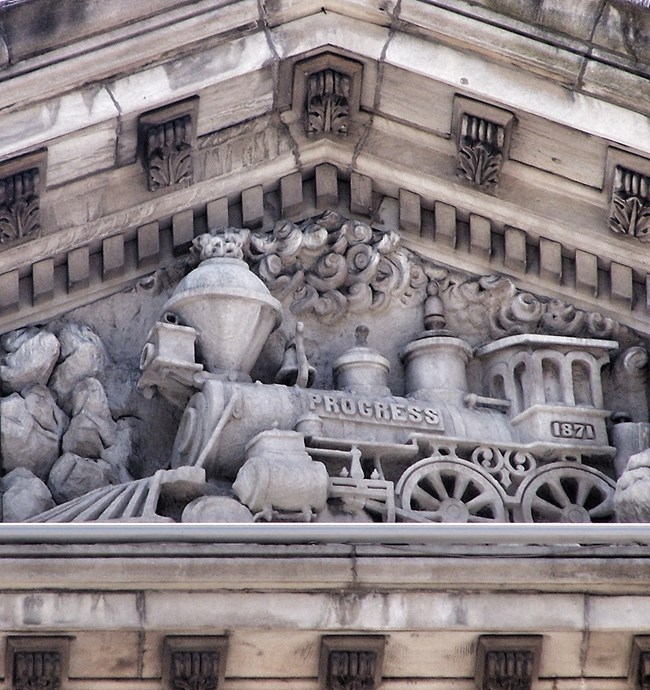Part of a series of articles titled Creative Teaching with Historic Places: Selections from CRM Vol 23 no 8 (2000).
Article
Visualizing History: Inquiring Minds Want to Know

https://www.loc.gov/resource/hhh.ga0544.photos/?sp=3
Published by the National Park Service, Cultural Resources
by Beth M. Boland
Read any good buildings lately? How about landscapes? Or downtown streets, or your neighborhood, or the site of your last vacation? I’ll bet you have, although you may not be aware of it. Our minds constantly are processing visual as well as other data. From this information we make assumptions and draw conclusions about the world around us. It is amazing how much we do not really see on a conscious level. And yet, if we focus our powers of observation, we find we know more than we realize.
Teaching with Historic Places (TwHP) offers a variety of workshops on using places in the classroom or in other educational programs for teachers, preservationists, historians, and the general public. These workshops usually begin with our interactive “Power of Place” slide presentation illustrating the nation’s rich variety of cultural resources. These images coax our audiences to begin thinking of historic places in their own communities, and they also encourage a process of purposeful observation and inquiry, which can be applied to places back home.
For many people, historic sites mean places like Mount Vernon, Gettysburg Battlefield, and the Chrysler Building. There is no question of the importance these landmarks and other American icons have had in shaping our cultural identity. But while there is only one national capitol, there are 50 state capitols and countless county courthouses, city halls, and municipal buildings. Every state and locale can boast special places embodying the important stories of past people and events. These places are sources of evidence that document how those who came before us lived and died, worked and played, expressed their creativity and beliefs, and governed themselves. We want people to become more aware of their community resources, the place they may walk by every day.
As the slides appear, everyone wants to know where places are located. Often, we will ask the audience to guess the location, or at least the region of the country, based on the physical evidence they see before them. A beautiful Romanesque stone building with spires topped by somewhat lumpy cones offers clues to its location. Those cones are beehives and the building is Salt Lake City’s City Hall, in “The Beehive State.” A different city hall in another area of the country displays even more provocative symbolism, which we ask the audience to decipher. A locomotive flanked by two very different trees fills a classical pediment bearing the date 1871. We are so used to seeing pictorial carvings on public buildings that we rarely question their meaning. But these images were chosen from infinite possibilities for a reason. What citizens in what place at that time would create this tableau, and to convey what message?
Similarly, we lead participants through a variety of places with differing types of clues. The ruins of a tabby (a material largely made of seashells) slave hospital in Georgia speaks of the regional environment within which early settlers lived, but a 19th-century adobe house in Santa Fe scored and painted to look like brick poses a more difficult puzzle. Chinatowns present obvious clues about ethnicity, but the more subtle terraced Chinese gardens in Idaho’s Payette National Forest tell an important story, too. As we proceed, we ask for increasingly sophisticated observation, analysis, and hypotheses, and ideas about what other types of evidence would complete the story. The picture of an attractive Italianate house elicits little interest until it is paired with a historic aerial photograph showing the house sitting in isolated splendor against a vast background of farmland. The appearance of the second image produces an audible gasp every time. And incidentally, how did they get that aerial shot in the 1870s?

https://www.flickr.com/photos/onasill/13747457425
We always end the presentation with a slide showing an unidentified place and ask participants to guess what it is. Every theory must be supported with some specific evidence from the picture they are inspecting. For one modest building, many suggest a country church or school. When asked why, they may identify the two front doors and speculate that they may have been used for women and men parishioners or white and Black students. We answer, “Maybe, but what else do you see that contradicts or supports that hypothesis?” Our most important goal for “Power of Place” is to spark enthusiasm and inquisitiveness about historic places, to help people questions the who, what, where, when, and how of places. What do the choices, conscious or unconscious, made by people of the past tell us about who they were and how they lived?
Many of those who attend our workshops are classroom teachers who know that questions lead to a search for answers, which leads to learning, which is their goal for students. Standards for historical thinking in the National Standards for History state,
“True historical understanding requires students to engage in historical thinking to raise questions and to marshal solid evidence in support of their answers; to go beyond the facts of their textbooks and examine the historical record for themselves; to consult documents, journals, diaries, artifacts, historic sites, works of art, quantitative data, and other evidence from the past, and to do so imaginatively.”[1]
That true historical understanding and imaginative examination of evidence ideally result in what many call an empathetic understanding of the past, on its own terms, detached from our modern cultural biases. For as historian David McCullough notes, “The past, after all, is only another name for someone else’s present.”[2]
Places have stories to tell. But like any good mystery, these tales require some sleuthing. You must look for clues and put them together in the right way to “solve the case.” And to get the whole story, you must combine what you have learned from the place itself with information from other sources. By the way, that 1871 city hall pediment with the train and the trees? One tree is a northern pine and the other a southern palm. Louisville, Kentucky was proclaiming itself an engine of prosperity and reconciliation in the years following the Civil War.
[1] National Center for History in the Schools. National Standards for History, Basic Edition (Los Angeles: University of California, 1996), 59. National Standards for History is an abbreviated version of the National Standards for United States History published in 1994.
[2] David McCullough, Brave Companions: Portraits in History (New York: Prentice Hall Press, 1992), xiv.
At the time of publication, Beth M. Boland was a historian with the National Register of Historic Places and the Teaching with Historic Places program manager.
Last updated: July 2, 2019
